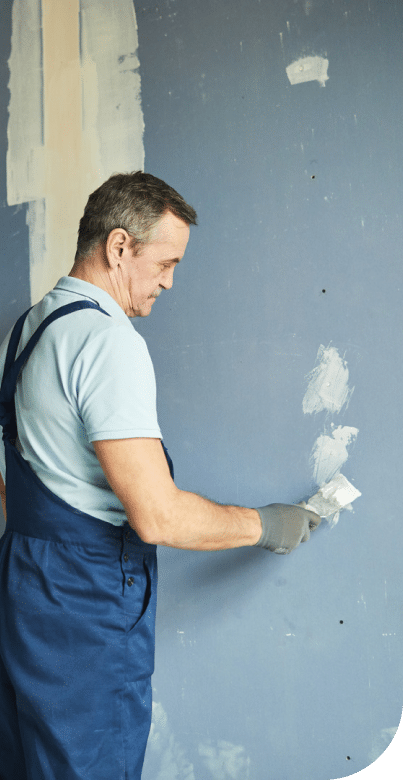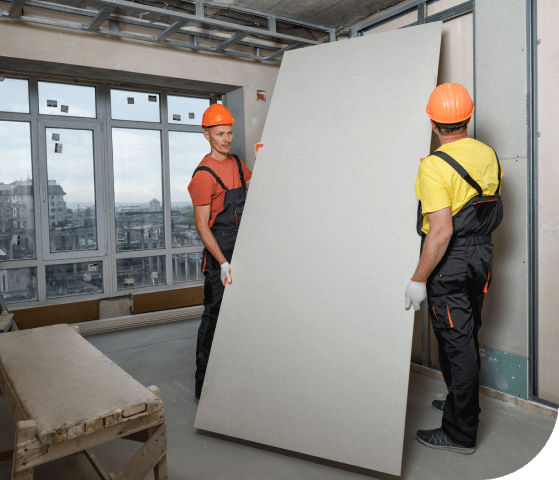Asbestos in Drywall
Drywall is the primary material in walls, ceilings, and partitions in most residential and commercial buildings in the United States. From 1940 to 1980, asbestos was added to drywall components for strength and reinforcement. Exposure to asbestos in drywall may occur at home or in the workplace, resulting in a risk of developing asbestos-related illnesses later in life. If you or a loved one has been diagnosed with mesothelioma, contact the Lanier Law Firm today for a free consultation.
Home » National Mesothelioma Law Firm » Asbestos Exposure » Asbestos in Consumer Products and Materials » Asbestos in Drywall
Which drywall components contain asbestos?
Where was asbestos drywall used?
What does asbestos drywall look like?
Is drywall the only wall and ceiling component that contains asbestos?
What should I do if I live or work in an older building with asbestos drywall?
What occupations have been impacted by asbestos drywall?
Drywall is a lightweight, gypsum-based wallboard that is typically sold as four-foot by eight-foot sheets ranging in thickness from a quarter inch to five-eighths of an inch. They are also known as sheetrock. Sheetrock was originally a brand name trademarked by the United States Gypsum Company. Due to its popularity, it became synonymous with drywall.
Drywall sheets are attached to wall studs side by side to form a wall surface. Drywall tape and joint compound conceal the seams and installation hardware to create a smooth appearance. Asbestos exposure may occur during the installation or repair of these products, or when they become damaged.
Which drywall components contain asbestos?
The components most likely to contain asbestos are joint compound and drywall tape. Drywall boards may contain asbestos, but this was not common. Drywall tape was made from paper. Asbestos was a common ingredient in paper products from the 1930s until the late 1970s because it provided strength and fire resistance.
Joint compound is also known as drywall mud or spackle. It may be purchased dry and mixed with water to form mud, or it can be purchased premixed. It may be used for small drywall projects and repairs in addition to drywall seam coverage.
Asbestos was used in joint compound to obtain the following benefits, according to Critical Reviews in Toxicology:
- Improve its flexibility during application, resulting in a smoother texture for painting
- Prevent the compound from shrinking and cracking as it dried
- Increase the product’s temperature stability so that it could be used after being stored at freezing temperatures

When was asbestos drywall used?
Before drywall was used, interior walls were generally built from lath and plaster. Lath was thin strips of wood, rock, or metal that formed walls. These were covered with plaster, which could then be painted or textured. This was time-consuming, expensive, and labor-intensive.
The United States Gypsum Company invented the first commercially viable drywall sheets in 1916. In 1921, the company advertised Sheetrock as a fireproof wall that went up quickly. During the building boom in the 1940s that preceded the end of World War II, Sheetrock became the material of choice and replaced lath and plaster.
Does drywall have asbestos today?
In 1977, the Consumer Products Safety Commission banned asbestos in joint compounds and drywall tape. However, these products may still have been used until 1980 or later from the oversupply that had been purchased prior to the ban. As a result, buildings constructed before 1990 may still contain asbestos in drywall.
What does asbestos drywall look like?
Drywall and joint compound have a whitish appearance. It may have added texture or paint coatings. The material itself may be smooth or rough depending on the skill and method with which it was applied.
There is no way to tell through visual inspection whether drywall contains asbestos. If it does contain asbestos, it is likely in the tape or joint compound. The only way to know with 100 percent certainty whether your drywall contains asbestos is to have it professionally tested.
Is drywall the only wall and ceiling component that contains asbestos?
During the period when asbestos drywall was used, asbestos was also used in several other interior wall and ceiling products, including the following:
- Insulation
- Ceiling tiles
- Popcorn ceilings
- Electrical wiring
- Texture compound
- Paint
As a result, drywall workers and do-it-yourself homeowners may be exposed to asbestos through these products when working with drywall.
What should I do if I live or work in an older building with asbestos drywall?
Asbestos is only considered dangerous when it has been disturbed. Intact asbestos drywall in good repair may not be hazardous.
Commercial Buildings with Asbestos Drywall
State asbestos regulations generally require most owners of older commercial buildings to perform inspections at specified intervals and prior to renovations and demolitions.
If testing reveals asbestos hazards, the owners must follow the recommendations of the licensed asbestos abatement contractor for remediation. If the asbestos can be encapsulated, this is often the safest method of containing it. Otherwise, it must be removed. In either case, these actions should only be performed by licensed professionals.
Residences with Asbestos Drywall
State inspection regulations generally do not apply to older residences with four or fewer units, including single-family homes. If you suspect the presence of asbestos in your drywall, you will need to have the drywall and your air quality tested by a licensed, professional testing company.
If air quality testing reveals the presence of airborne asbestos fibers, you will need to hire an asbestos abatement professional to remove the asbestos. Whether you suspect asbestos in your drywall or have confirmed it, it is crucial to your safety that you abide by the following guidelines:
- Do not try to remove the asbestos yourself.
- Do not puncture, drill, cut, sand, or otherwise damage the material.
- Do not hire the same company to both test and abate the asbestos.

Asbestos abatement can be an expensive process. Companies that both test and abate asbestos have a vested interest in a positive test result. Hiring a separate company for each activity will avoid this conflict of interest.
While it is generally advised to leave asbestos products in place if the asbestos is not damaged or airborne, if you plan to do any of the following, you should have the asbestos removed first, as these actions could damage the asbestos and release it into the environment:
- Hanging pictures
- Bracing heavy furniture
- Hanging a television
- Installing cable or audio-video equipment
- Installing wiring
- installing additional outlets
- Renovating
What occupations have been impacted
by asbestos drywall?
Any worker involved in the manufacture, installation, or repair of asbestos drywall may have experienced significant asbestos exposure. However, drywall workers are not the only workers that may be exposed.
Workers in environments where asbestos drywall is being installed or repaired, as well as those whose professions require them to damage walls, may face occupational exposure to asbestos in drywall. This includes workers in the following occupations:
- Audio-video equipment installers
- Cable installers
- Carpenters
- Construction workers
- Demolition workers
- Drywall finishers
- Drywall installers
- Electricians
- Factory workers that manufacture drywall products
- Firefighters
- Furnace workers
- Handymen
- Industrial workers
- Insulators
- Laborers
- Maintenance workers
- Painters
- Plumbers
- Teachers
Joint compound is applied wet, allowed to dry, then sanded in order to make it blend with the rest of the drywall. This creates significant dust with heavy asbestos exposure, resulting in a heightened risk of asbestos illnesses. Our law firm won a $4.5 million asbestos verdict on behalf of a man who developed an asbestos-related illness from two years of asbestos exposure through joint compound.
Companies That Exposed Workers to Asbestos in Drywall
The following asbestos companies manufactured or supplied asbestos drywall to the public or required workers to perform asbestos drywall installation, repairs, or work that required them to damage asbestos drywall:
- Ace Hardware Corporation
- Elof Hansson, Inc.
- Grand Rapids Gypsum
- Homasote Company
- KCG, Inc.
- McMaster-Carr Supply
- Murco Wall Products
- Sears, Roebuck, and Company
- The Cleveland Builders Supply Company
- The Cleveland Gypsum Company
- The Sherwin-Williams Company
The companies below also exposed workers to drywall asbestos, but they have since reorganized under Chapter 11 bankruptcy and established asbestos trust funds for the benefit of exposed workers who later develop mesothelioma, asbestos lung cancer, and asbestosis:
- Bondex International
- Brauer Supply Company
- Celotex
- Flintkote Company
- Johns Manville
- Kaiser Gypsum
- National Gypsum Company
- Owens Corning
- Porter Hayden Company
- Synkoloid Company (ARTRA Group)
- The Fibreboard Corporation
- United Gilsonite Laboratories
- United States Gypsum Company
How can a mesothelioma lawyer help?
If you have been exposed to asbestos in drywall, you may be eligible for substantial asbestos compensation. We have more than 30 years of experience helping asbestos exposure victims stand up to the companies that wrongfully exposed them to asbestos.
We can help you file an asbestos exposure lawsuit, an asbestos trust fund claim, or a workers’ compensation claim. Our clients often find that they are eligible to file multiple mesothelioma claims. We are passionate about ensuring our clients receive the maximum compensation available to them. Contact us today for a free consultation.
By submitting this form, you agree to our terms & conditions. Please read the full disclaimer



